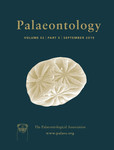Reg. Charity No. 1168330

Non‐avian theropods were a highly successful clade of bipedal, predominantly carnivorous, dinosaurs. Their diversity and macroevolutionary patterns have been the subject of many studies. Changes in fossil specimen completeness through time and space can bias our understanding of macroevolution. Here, we quantify the completeness of 455 non‐avian theropod species using the skeletal completeness metric (SCM), which calculates the proportion of a complete skeleton preserved for a specimen. Temporal patterns of theropod skeletal completeness show peaks in the Carnian, Oxfordian–Kimmeridgian and Barremian–Aptian, and lows in the Berriasian and Hauterivian. Lagerstätten primarily drive the peaks in completeness and observed taxonomic diversity in the Oxfordian–Kimmeridgian and the Barremian–Aptian. Theropods have a significantly lower distribution of completeness scores than contemporary sauropodomorph dinosaurs but change in completeness through time for the two groups shows a significant correlation when conservation Lagerstätten are excluded, possibly indicating that both records are primarily driven by geology and sampling availability. Our results reveal relatively weak temporal sampling biases acting on the theropod record but relatively strong spatial and environmental biases. Asia has a significantly more complete record than any other continent, the mid northern latitudes have the highest abundance of finds, and most complete theropod skeletons come from lacustrine and aeolian environments. We suggest that these patterns result from historical research focus, modern climate dynamics, and depositional transportation energy plus association with conservation Lagerstätten, respectively. Furthermore, we find possible ecological biases acting on different theropod subgroups, but body size does not influence theropod completeness on a global scale.
AcknowledgementsThe authors would like to acknowledge Phil Mannion (Imperial College London), Paul Upchurch (University College London) and Roger Close (University of Birmingham) for their support and discussion. We would also like to thank the following people for providing access to information or images of specific specimens: Philip Currie (University of Alberta); Martin Ezcurra (Museo Argentino de Ciencias Naturales); Amy Balanoff, Alan Turner (Stony Brook University); Vince Schneider, Lindsay Zanno (North Carolina Museum of Natural Sciences); Carolyn Levitt (Natural History Museum of Utah); and James Kirkland (University of Utah). We thank Mickey Mortimer for the dedication and effort towards ‘The Theropod Database’ (http://theropoddatabase.com), an invaluable online resource we used as a basis for many literature searches. We would further like to thank the reviewers for their constructive comments that improved the manuscript. This research was funded by the European Union's Horizon 2020 research and innovation programme 2014–2018 under grant agreement 637483 (ERC Starting Grant TERRA to RJB).